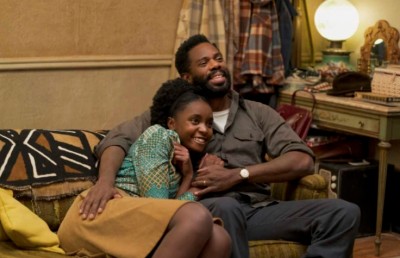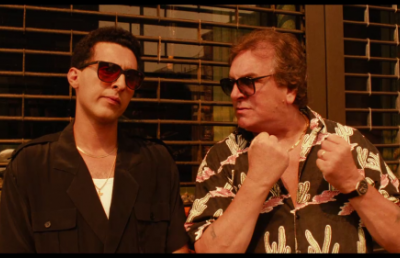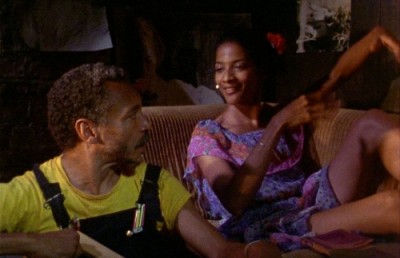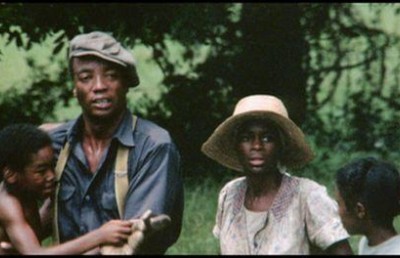The BlackKklansman (Spike Lee, 2018)
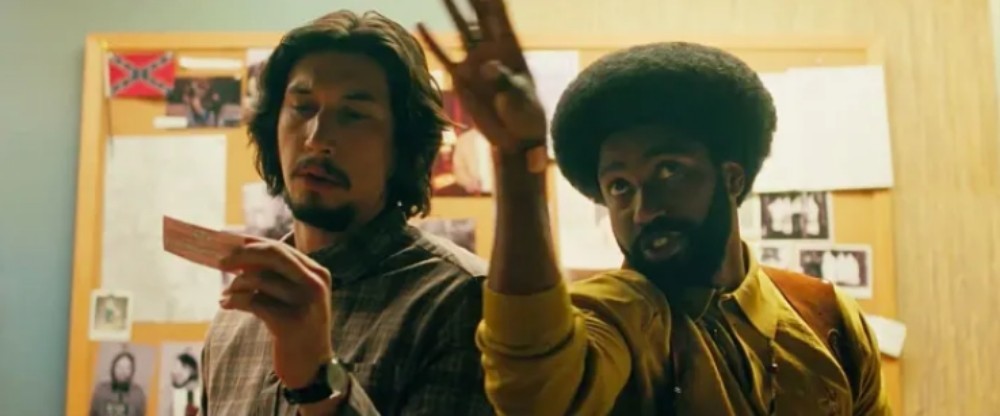
Lee returns to the theme of his masterpiece, Do the Right Thing, racial strive in America, with his most audience friendly film in a long while, the reality-based period piece, The BlacKkKlansman. The film is based on the true story of police officer Ron Stallworth, who as the first black officer in Colorado, Colorado Springs, didn’t exactly ease his way into the job by coming up with a strategy to infiltrate the Colorado chapter of the Ku Klux Klan. His plan was to respond to a KKK advert asking for recruits, using his best “white” voice and then using a white officer to attend in person meetings, a secular Jewish officer named Flip played by Adam Driver. The film lacks the full incendiary power of Do the Right Thing, but it has its moments of power, mainly in response to how it mirrored America circa 2018 and in the strength of its young, black characters. Ron’s first undercover assignment comprises one of the film’s best scenes, attending a speech by Stokey Carmichael (name changed to Muslim Kwame Ture) to assess the mood of the crowd and gauge whether his words can stir the black youth to dangerous rebellion (i.e. Communist). The scene recalls the opening meeting amongst UCLA mixed race union students debating the best way to forge real change in Zabriskie Point, the main difference being the less staged nature of the earlier film. Carmichael held positions ranging between Martin Luther’s non-violent protest and Malcolm X’s any means whatever, but in this speech he is riled up and clearly trying to light a fire under these young, educated Black students. The intensity of his speech and its impact on each individual in the room is captured by Lee with a unique series of close-ups (mostly three-shots) of the listeners set off against an all-black void-like background, which gives the characters the appearance of floating in space from side to side or toward the camera. I immediately thought of the way Jordan Peele (who is one of the producer’s of this film) used the black space in the moments where the Chris free falls into a black void, the ‘sunken place’. (According to most definitions, the Sunken Place is a trance-like, otherworld state that the black victims of hypnosis performed by Armitage family matriarch Missy, played by Catherine Keener, are trapped in when their bodies are taken over by white hosts. The condition has become a symbol of the unwitting oppression of black people. Or more generally, a symbol of social paralysis where poor or oppressed people have no sense of agency.)
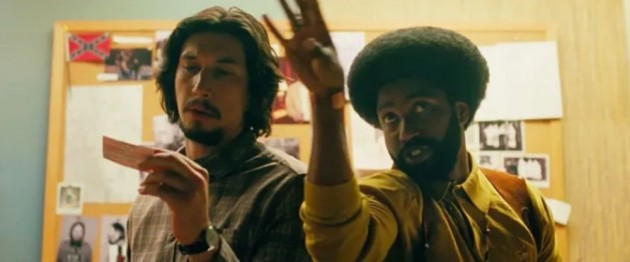
While undercover at the talk Ron, who is wearing a hidden microphone to capture the speech and reactions, seems genuinely moved by the great orators words. This scene also serves to set-up a love interest between the highly politicized woman who is head of the student union and organizer of Stokey’s visit, Patrice Dumas (Laura Harrier), and Ron; a love interest which only drags the film down by seemingly appeasing the mainstream crowd who expect a love interest in every film. Influential black film critic Armond White has been critical of what he sees as Lee’s conceding to the white liberal sect which comes clear in the positive depiction of the police officers. Only one officer within the precinct is (at least overtly) racist, Patrolman Andy Landers (Frederick Weller). Landers is clearly written to be an unsympathetic character, but he is removed from his position of power using the same method Ron used to frame the KKK (wearing a mike) in a post-climax scene which seems aimed directly at the liberal white crowd which White would claim creates a scenario of harmony between white cop/black cop which feels less threatening than if the racist officer would have remained unpunished and left to spread his hatred within the ‘Brotherhood’.
The depicted white supremacists in BlacKkKlansman are all too easy to hate, and come across as more buffoonish that terrifying. While the David Duke character is played with boyish charm, seemingly more concerned with image than substance. The scene near the end where Ron calls Duke from the police station with all the other non-racist white officers in on the joke to reveal how Duke was fooled by a black man also feels tacked on for entertainment purposes and to generate a ‘good feel’ moment, which in fact, goes against reality as after the case was made public and arrests made, Ron kept his involvement secret until his retirement in 2005.
Whenever a filmmaker takes it upon themselves to make a film bearing a political statement there is the dilemma of dialing it up cinematically and thematically to make the message more rigorous, at risk of alienating the people who need to be addressed (not speaking to the converted). Or tempering the style and message to appeal to a broader audience. Lee has chosen the latter with BlacKkKlansman, and has made a film which entertains while injecting moments of more expressive form or content. And Lee reserves this for the end of the film, in contrast interestingly enough, to DTRT, which ends with a conciliatory note after the ‘fiery’ penultimate scenes. In BlacKkKlansman, after the police bust the KKK organization, which included two former military veterans with paramilitary experience, the police hierarchy are told to close down the case and keep everything hush, claiming that there is no longer any apparent threat and setting up the end by congratulating themselves that there was no cross burning during the investigation. Budget cut backs, claims the well-meaning but paternalistic Chief Bridges. All the good cops and detectives involved in the assignment are upset by the decision, and leave Bridge’s office with their tails down, Ron, Flip (Driver), Sergeant Trapp (Ken Garito) and Jimmy Creek (played by Steve Buscemi’s brother Michael).
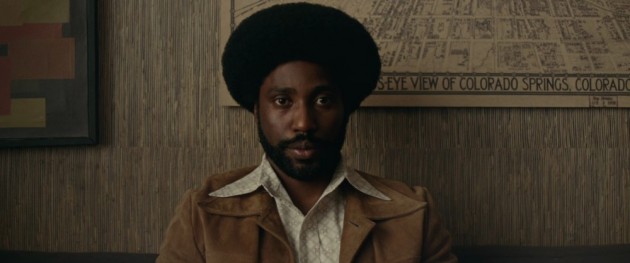
In the final scene featuring Ron he is enjoying a soiree with Patrice. Disconcerting off-screen sounds add an unsettling mood. Followed by a knock on the door. Ron and Patrice, gun cocked to fire, open the door but are met by a long empty corridor with a window at the end. Framed in medium close-up, Ron and Patrice are glued in place, the camera pulling them back through space like two frozen cut-outs (filmed most likely with the two actors standing on the dolly with the camera). A reverse cut shows a glowing fire outside the window; a closer look and we see a KKK gathering at a cross burning. A rebuttal to the earlier claim by Chief Bridges (Robert John Burke, who first caught my eye as the super hip shape shifting demon in Richard Stanley’s mesmeric Dust Devil) that there were no cross burnings during the investigation. A vivid eyeball close-up reflects the burning cross as if etched in the collective memories of history: DO NOT REPEAT is what Lee seems to be saying. (In an odd way this clandestine night time scene reminded me of the gobsmackingly unnerving ending featuring the soaring witches in The Witch, 2015.) The action appears to be somehow outside narrative time and space, which cues us for the surprise, maybe jarring cut to news footage of the Charlottesville riots during the Unite the Right rally of August 11 and August 12, 2017, which saw clashes between anti-Semite, Neo-Fascist, Pro-South, alt-right and White Supremacists and a sub-section of the population that united as counter-protestors. A terrorist attack with a car driving through the protestors caused the death of one counter-protestor, Heather Heyer (identified by Lee in a touching epitaph right after the news footage showing the rampaging car, “Heather Heyer, May 29th, 1985-August 12th, 2017, Rest in Power”). The reason Lee broke the fictional wall with this scene is clear to anyone with eyes: America as a Nation has not gone much beyond the events of the fictional world; racism is still an American National blight. Given that Lee’s film goes out of its way to reference the KKK’s hatred of Jews (as well as gays) this intrusion into real world politics recalls Steven Spielberg’s decision to end Schindler’s List with documentary footage of “128 survivors pay[ing] their respects at Schindler’s grave in Jerusalem” (Wikipedia, Schindler’s List entry). Perhaps the most forceful and potentially contentious gesture in the film is the upside down American flag that fills the screen right after the Heather Heyer obituary which shifts from color to black and white. According to The United States Flag Code, “The flag should never be displayed with the union down, except as a signal of dire distress in instances of extreme danger to life or property” https://catcountry1029.com/what-does-upside-down-american-flag-mean/.
While this use of real politics functions in the manner intended by Lee, a Brechtian WAKE-UP call, an earlier scene which crosscuts between Harry Belafonte playing himself (at the ripe age of 91) recalling the initial impact of Birth of a Nation and members of the KKK watching Birth of a Nation while superficially poignant feels too pointed and obvious. Belafonte is holding court over the same captive young black audience from the earlier University scene, recalling the lynching of a black man by the KKK one year after the release of Griffith’s notorious Birth of a Nation) (1915). Lee then cuts to the members of the KKK gleefully watching and enjoying a screening of Birth of a Nation at an initiation celebration. The point in contrast presents moments in history that should be known to anyone with even a passing interest in film history (like Birth of a Nation being screened at the White House and applauded by President Woodrow Wilson, who was a classmate of the author of the novel on which the film was based, Thomas Dixon, The Clansman). And to complete Belafonte’s quote on what Wilson said about the film, “It is like writing history with lightning.” He then added, “And my only regret is that it is all so terribly true.” Pitting a great person like Harry Belafonte, who lived through some of the darkest hours in black history, and marched with Martin Luther King in Alabama, against the buffoons chuckling at Birth of a Nation while scoffing popcorn and acting like Griffith’s film invented the post-Civil War history, makes for an uneasy, if cinematically interesting, historical connection. It does of course serve the formal connection in the crosscutting between Belafonte and the KKK of Lee’s narrative, work. There is a direct cause and effect correlation between Birth of a Nation and the KKK in the period Belafonte is speaking about. We know now that the popularity of the film, which kept playing nationally well into the 1920s, helped increase the profile of the KKK (and alternatively, also the just formed NAACP, which gave them something they could band against). The KKK formed in the Southern states and flourished in the 1860s and died out by the 1870s. The popularity of the film saw a spike in KKK membership starting in 1915 which saw members rise as high as five million by the end of World War 2, while also moving beyond the South. The KKK even used Birth of a Nation as a recruiting device. Hence there is a real historical link that exists between the film and the lynching that Belafonte orates. But can we say the same about the film and the KKK in the late 1970s, or indeed in 2016 or 2017 or 2018? Or put another way, what more can we read into the crosscutting from Belafonte to the KKK than just the formal convenience?
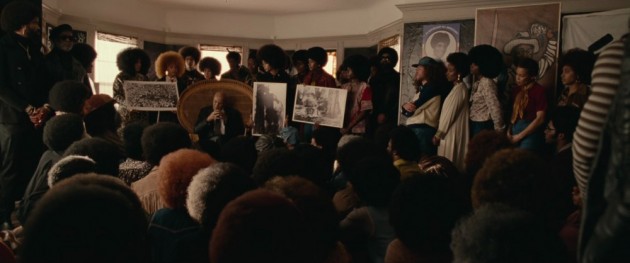
From Hallsworth’s account David Duke did show Birth of a Nation at KKK initiations. I am certainly not a historian, but from most accounts the next historical moment that increased KKK presence was the beginning of the Civil Rights movement in the late 1940s and 1950s, where the attempts of black Americans to challenge racist laws was met by KKK acts of terrorism, such as cross burnings, lynching, attacks on property and church bombings. The inclusion of news footage of the Charlottesville riots of August 11-12, 2017 clearly states that the “philosophy” of White Supremacist and the KKK is alive and well in America. But the jump from 1979 to 2017 leaves a lot unsaid. After-all, Lee is a filmmaker who wants to entertain as well as raise important issues.

But I think there is much implied by Lee in his book-ended pre-credit fictionalized prologue scene and the real news footage that ends the film. The film begins with that other once (still?) highly esteemed American Civil War classic, Gone With the Wind, which is a lead-in to Alec Baldwin playing (hilariously I should add) fictional 1960s racist Anti-Segregationist Dr. Kennebrew Beauregard, who seems to be rehearsing a hate-filled political speech to an off-screen coach. The Beauregard character spouts a litany of fear mongering, anti-Communist, anti-Black, anti-Semite rhetoric, all while a 16mm print of Birth of a Nation is brilliantly projected over his body. The casting of Alec Baldwin is certainly not a coincidence, as his hilarious impersonations of Douglas Trump on Saturday Night Live have become etched in comedy satire history.
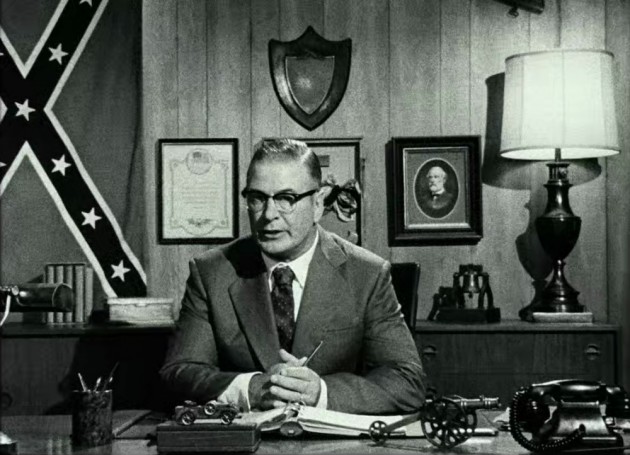
To return to my earlier question, what more can we read into the crosscutting from Belafonte (1915s) to the KKK (1970s) than just the formal convenience? By bookending the fictionalized racism from 1915 (Birth of a Nation), to 1939 (Gone With the Wind) to the 1960s (Dr. Kennebrew Beauregard) with the REAL 2017 Charlottesville riot, Lee just might be suggesting (or at least I am reading this into the crosscutting scene) that the rise of the alt-right and Far Right and the White Supremacy movements in America is a long, slow counter-reaction to 8 years of having a black U.S. President (Obama), the 2013 International Black Lives Matter, the increased profile of African Americans in positions of media, the mainstreaming of hip hop and Rap culture, the very vocal opposition to the lack of diversity in Hollywood at the recent Academy Oscar awards, to the interesting and in some cases high profile and award winning wave of black-themed films in recent years (The Help, Precious, Moonlight, Fences, Selma, The Birth of a Nation, Get Out, I am Not Your Negro, A Wrinkle in Time, Black Panther, Harriet, Bodied).
In the end, BlacKkKlansman is an entertaining, at times provocative piece of agit-prop for a mainstream audience, with a special shout out to black audiences. It is probably Spike Lee’s best film since Inside Man (2006). It is not, nor does it try to be, as radical a piece of agit-prop as, say, The Final Comedown (Oscar Williams, 1972) or Sweet Sweetback’s Baadassss Song (Melvin Van Peebles, 1971), a film which is literally credited “Starring THE BLACK COMMUNITY”, or even Robert Downey Sr.’s satirical Putney Swope (1969), but it will surely have a broader appeal than those nuggets of black cinema. It is a far cry from Do the Right Thing, but in his own way, Spike Lee continues to “Fight the Power”.
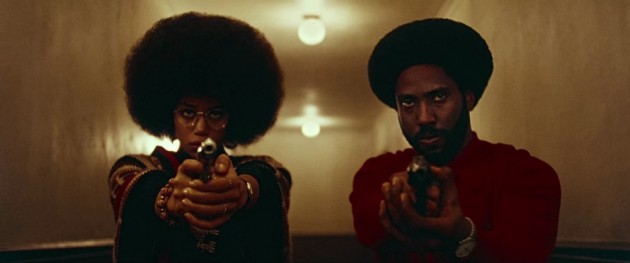
The striking corridor shot
Most viewers of the film will not be familiar with an earlier film entitled The Black Klansman (1966, Ted V. Mikels), an earnest raceploitation film with a similar plot to the Lee film. When a light skinned black man’s daughter is killed in a church bombing he returns to the South, where his daughter lived with her grandmother, and infiltrates a KKK group by donning ‘white-face’ with the hope of enacting revenge. Whereas in BlackKklansman the infiltrator is split across two characters, a white cop and a black cop, in The Black Klansman white actor Richard Gilden plays a light-skinned black man, Jerry Ellsworth, who plays white-face (in a rare instance of playing white-face). In black and white cinemascope, the film is more serious than the title would suggest and depicts racial injustice with a calm, measured style. Elements of the story –the father of a murdered boy hires Harlem gangsters to get his revenge– foreshadow the 1970s blaxploitation cycle of black-empowerment films. With respect the latter, anyone wanting to see some genuine homage from Lee to the blaxploitation genre will be disappointed with the lip service Lee plays to this under-appreciated cycle of films, in a brief scene where Ron tries to convince Patrice of the relative merits of Shaft, Superfly and Coffy (Lee interjects full-size posters of each film they discuss). Though I had to smile when I noticed Lee’s homage to White Heat (1949) in the scene where Ron has been tasked to act as security for David Duke (Topher Grace) and is ‘outed’ by a KKK member who recognizes him as the cop that arrested him, a plot action which plays out in exactly the same way in the James Cagney vehicle where a member of Cody Jarrett’s gang outs the infiltrator in Jarrett’s gang, played by Edmond O’Brien, as a cop who arrested him years ago.



